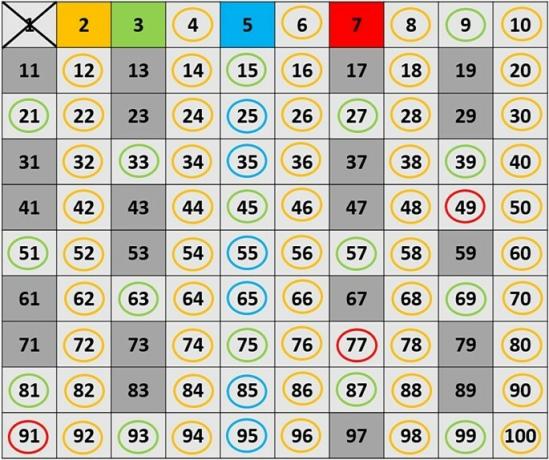The numbers emerged more than 30,000 years ago when humans had to count objects and animals.
When they felt the need to count what they hunted or fished, primitive men and women would draw animals on the walls to indicate their numbers.
As time went by, people lived in larger groups, the tribes, and each one of them developed a way of counting. Therefore, numbers were not invented by one person, but by several peoples.
In this text, we'll find out how numbers emerged in prehistory and what the way of counting from Babylonians, Romans, Hindus and Arabs, the peoples who most influenced the numbering we use at the moment.

Numbers in prehistory
From the moment that humans who became sedentary, that is, settled on the land to cultivate it and began to domesticate animals, individuals had to find ways to count.
This happened because it was necessary to control how many animals they owned. Thus, they started to relate to objects. For example: each animal was worth a stone. When they took the animals to graze, they placed a stone in a bag, corresponding to each animal. At the end of the day, when the animals returned to the pen, it was enough to count the stones in the sack to know if everyone was there or if any had been lost.
They also used traces marked on tree branches or animal bones. One stroke corresponded to one object, two strokes to two objects, and so on.
These methods were good for small amounts. However, when it was necessary to tell many things it got more complicated. One of the ways found to facilitate counting large quantities was to group the objects every ten units. This is because we have ten fingers on our hands.
History of Babylonian Numbers
As villages became cities and cities became empires, trade between peoples grew and there was a need to create more accurate records.
This was the case of one of the great Babylonian civilizations, which built an empire from 1792 BC. C.-539 a. C., in the territory that corresponds approximately to the current Iran and Iraq.
To control taxes and trade between regions of the kingdom, the Babylonian peoples perfected the counting system. They wrote the values with symbols and these occupied different positions according to the quantity that was wanted to be registered, exactly as we do today. After all, when we write 14, it's not the same as 41, although we use 1 and 4.
This made counting and calculations easier, as there was no need to invent new symbols to write very large numbers.
Babylonian numbers were written in a cuneiform way, that is, using a wedge, which was a pointed instrument that allowed engraving in clay. Let's look at an example:

The numbers and the Babylonian mathematical system were taken advantage of by the Hindus.
History of Roman Numbers
If the Babylonians used symbols, the Romans used letters to represent numbers.
They used the letter "I" to count from 1 to 3, then grouped the quantities into every five units, five tens, a hundred and a thousand. Combining the letters it was possible to write the quantities.
| Letter | Number |
|---|---|
| I | 1 |
| V | 5 |
| X | 10 |
| L | 50 |
| Ç | 100 |
| M | 1000 |
Even today, Roman numbers are present in our lives, to indicate book chapters or centuries.
In Roman numeration, the order of the letters was fundamental to compose the value of the numbers. If we put the letter "I" before the "X", we have "IX", and we are writing the number nine. However, if we place the "I" after the "X", we have "XI", and we get the number eleven.
Roman numbers were good for counting but not for calculating. Thus, they were replaced by Indo-Arabic numerals.
Origin of current numbers
Indo-Arabic numerals are the form of writing we use today. It was created by the Hindus and spread throughout the Western world by the Arabs. Hence it is called Indo-Arabic.
The Hindus developed a system where each number was a symbol and it was not necessary to write a different sign to indicate each grouping of objects, as the Egyptians had done. Like the Babylonians, numerals occupied different positions according to their value.
One of the most important mathematicians of the Middle Ages, al-Khwarizmi, who lived from 780 to 850, used this way of writing numbers in his calculations. The name of this scholar in Latin was "Alcuarismi" and hence the word "algarismo" in Portuguese.
Al-Khwarizmi translated several Hindu works into the Arabic language and these arrived in Europe through southern Spain, which belonged to Muslims. One of those responsible for introducing this numerical system into the Christian world was Pope Sylvester II, who had studied works by Islamic mathematicians.
From then on, Indo-Arabic numbers conquered Europe and became the way to write quantities practically all over the world.
Origin of number zero
Zero was one of the last digits to be created. This happened because it did not represent a quantity of objects or animals, but the absence of value. The Romans, for example, did not represent zero.
The Babylonians, however, indicated the absence of value by leaving the calculation columns blank.
It was the Hindus in the seventh century, influenced by the Babylonian numbering system, who gave a name to the blank space left in the column of calculations: "sunya", which means "empty" or "gap". The word was translated into Arabic as "siphr" and passed into Latin as "zephirum", giving rise to the word zero, in Portuguese.
We have more texts for you:
- Numbers: what they are, history and sets
- History of Mathematics
- Egyptian numbering system
Bibliographic references
Assis, Jessica Roldão de Assis. The Origin of Numbers. Unicamp: Campinas. 2014.
Jacob, Jandira Luiza Martins. A historical approach to the origin of numbers. UFSC. Florianopolis. 2002.


